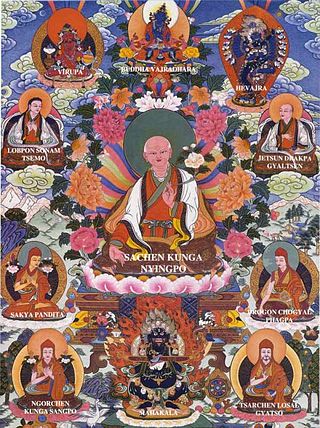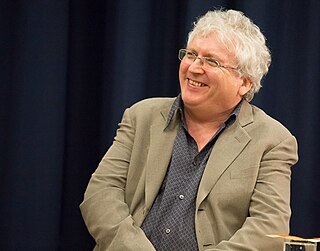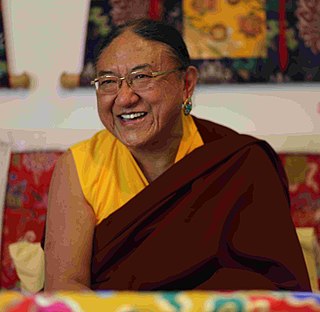
The Sakya school is one of four major schools of Tibetan Buddhism, the others being the Nyingma, Kagyu, and Gelug. It is one of the Red Hat Orders along with the Nyingma and Kagyu.

Drogön Chogyal Phagpa, was the fifth leader of the Sakya school of Tibetan Buddhism. He was also the first Imperial Preceptor of the Yuan dynasty and was concurrently named the director of the Bureau of Buddhist and Tibetan Affairs, serving during the reign of Kublai Khan.
Geshe or geshema is a Tibetan Buddhist academic degree for monks and nuns. The degree is emphasized primarily by the Gelug lineage, but is also awarded in the Sakya and Bön traditions. The equivalent geshema degree is awarded to women.

Sakya PanditaKunga Gyeltsen was a Tibetan spiritual leader and Buddhist scholar and the fourth of the Five Sakya Forefathers. Künga Gyeltsen is generally known simply as Sakya Pandita, a title given to him in recognition of his scholarly achievements and knowledge of Sanskrit. He is held in the tradition to have been an emanation of Manjusri, the embodiment of the wisdom of all the Buddhas.

Sakya Monastery, also known as Pel Sakya, is a Buddhist monastery situated in Sa'gya Town (ས་སྐྱ་), Sa'gya County, about 127 kilometres (79 mi) west of Shigatse in the Tibet Autonomous Region. The monastery is considered as the seat of the Sakya school of Tibetan Buddhism.

Sakya Trizin is the traditional title of the head of the Sakya school of Tibetan Buddhism.

Tibetan Buddhist architecture, in the cultural regions of the Tibetan people, has been highly influenced by Nepal, China and India. For example, the Buddhist prayer wheel, along with two dragons, can be seen on nearly every temple in Tibet. Many of the houses and monasteries are typically built on elevated, sunny sites facing the south. Rocks, wood, cement and earth are the primary building materials. Flat roofs are built to conserve heat and multiple windows are constructed to let in the sunlight. Due to frequent earthquakes, walls are usually sloped inward at 10 degrees.

Sa'gya County is a county under the prefecture-level city of Xigazê in the Tibet Autonomous Region, China.

Jigdal Dagchen Sakya Rinpoche was a Tibetan Buddhist teacher educated in the Sakya sect. He was educated to be the head of the Sakya school of Tibetan Buddhism as well as the successor to the throne of Sakya, the third most important political position in Tibet in early times. Dagchen Rinpoche was in the twenty-sixth generation of the Sakya-Khön lineage descended from Khön Könchok Gyalpo and was regarded as an embodiment of Manjushri as well as the rebirth of a Sakya Lama from the Ngor sub-school, Ewam Luding Khenchen Gyase Chökyi Nyima.

There were several Mongol invasions of Tibet. The earliest is the alleged plot to invade Tibet by Genghis Khan in 1206, which is considered anachronistic; there is no evidence of Mongol-Tibetan encounters prior to the military campaign in 1240. The first confirmed campaign is the invasion of Tibet by the Mongol general Doorda Darkhan in 1240, a campaign of 30,000 troops that resulted in 500 casualties. The campaign was smaller than the full-scale invasions used by the Mongols against large empires. The purpose of this attack is unclear, and is still in debate among Tibetologists. Then in the late 1240s Mongol prince Godan invited Sakya lama Sakya Pandita, who urged other leading Tibetan figures to submit to Mongol authority. This is generally considered to have marked the beginning of Mongol rule over Tibet, as well as the establishment of patron and priest relationship between Mongols and Tibetans. These relations were continued by Kublai Khan, who founded the Mongol Yuan dynasty and granted authority over whole Tibet to Drogon Chogyal Phagpa, nephew of Sakya Pandita. The Sakya-Mongol administrative system and Yuan administrative rule over the region lasted until the mid-14th century, when the Yuan dynasty began to crumble.

Dzongsar Monastery is a Buddhist monastery in Dêgê County in the Garzê Tibetan Autonomous Prefecture of Sichuan, China, southeast of the town of Derge and east of Palpung Monastery. Historically it lay in the Kham region of Tibet. It was founded in 746, destroyed in 1958, and rebuilt in 1983.

Tibet under Yuan rule refers to the Mongol-led Yuan dynasty's rule over Tibet from approximately 1270 to 1354. During the Yuan dynasty rule of Tibet, the region was structurally, militarily and administratively controlled by the Mongol-led Yuan dynasty. In the history of Tibet, Mongol rule was established after Sakya Pandita got power in Tibet from the Mongols in 1244, following the 1240 Mongol conquest of Tibet led by the Mongol general with the title doord darkhan. It is also called the Sakya dynasty after the favored Sakya school of Tibetan Buddhism.

Ratna Vajra Rinpoche, is a Tibetan Buddhist teacher who served as the 42nd Sakya Trizin from 2017 to 2022, considered one of the highest qualified lineage masters of both the esoteric and exoteric traditions of Buddhist philosophy and meditation. He is a descendant of the famous Khon family in Tibet, which holds an unbroken lineage of great and famous masters for over a thousand years. He is the eldest son of the 41st Sakya Trizin Ngawang Kunga. He teaches Buddhism and travels extensively throughout Europe, Asia, Australia, New Zealand and North America. Ratna Vajra was enthroned as the head of the Sakya school on 9 March 2017. On 16 March 2022, the throne of the Sakya school was passed by Ratna Vajra to his younger brother Gyana Vajra, who became the 43rd Sakya Trizin.

Lama Jampa Thaye is a teacher of the Sakya and Karma Kagyu traditions of Tibetan Buddhism. He has been teaching for over 30 years and is the spiritual director of the Dechen organisation of Buddhist Centres. He is the author of several books on Tibetan Buddhism and has a PhD in Tibetan Religions from the University of Manchester. He is renowned for being one of the first Westerners who are authorised to transmit Vajrayana teachings.
Buddhists, predominantly from India, first actively disseminated their practices in Tibet from the 6th to the 9th centuries CE. During the Era of Fragmentation, Buddhism waned in Tibet, only to rise again in the 11th century. With the Mongol invasion of Tibet and the establishment of the Mongol Yuan dynasty (1271–1368) in China, Tibetan Buddhism spread beyond Tibet to Mongolia and China. From the 14th to the 20th centuries, Tibetan Buddhism was patronized by the Chinese Ming dynasty (1368–1644) and the Manchurian Qing dynasty (1644–1912) which ruled China.

The dpon-chen or pönchen, literally the "great authority" or "great administrator", was the chief administrator or governor of Tibet based at the Sakya Monastery during the Yuan dynasty. The office was established in the 1260s and functioned as the Tibetan local government serving the Yuan emperors, unlike the Sakya Imperial Preceptors (Dishi) who were active in the Yuan imperial court.
The Imperial Preceptor, or Dishi, was a high title and powerful post created by Kublai Khan, founder of the Yuan dynasty. It was established as part of Mongol patronage of Tibetan Buddhism and the Yuan administrative rule of Tibet.
Serdok Penchen Sakya Chokden was one of the most important religious thinkers of the Sakya school of Tibetan Buddhism. He was a student of Rongtön Shecha Kunrig (1367-1449), Dönyö Pelwa, Künga Zangpo and many other Tibetan scholars. He also received empowerments and studied under several Kagyu lineages. Sakya Chokden's seat was the Thubten Serdogchen monastery in south Shigatse.
Khön Könchok Gyalpo was the founder of the Sakya School of Tibetan Buddhism, and the founder of Sakya Monastery. Khön Könchok Gyalpo was born in Sa'gya, Tsang. He was a member of the Khön family, and his ancestry can be traced back to Khön Dorje Rinpoche, student of Padmasambhava. He followed his father and brother and learned doctrines of the Nyingma School at a young age, but studied newly translated Vajrayāna texts with Drogmi Shakya Yeshe later. Khön Könchok Gyalpo established Sakya Monastery in 1073, where the Sakya Tradition first developed. His son Khön Kunga Nyingpo was regarded as the first leader of Sakya, and Khön Könchok Gyalpo is known as the first Sakya Trizin.

Sakya Trizin Ngawang Kunga served as the 41st Sakya Trizin, the throne holder of the Sakya Lineage of Tibetan Buddhism, from his appointment in 1952 until his retirement in 2017. His religious name is Ngawang Kunga Tegchen Palbar Trinley Samphel Wangyi Gyalpo. After passing the throne of the Sakya lineage to his elder son Ratna Vajra Rinpoche who became the 42nd Sakya Trizin on 9 March 2017, he is now known as Kyabgon Gongma Trichen Rinpoche.












